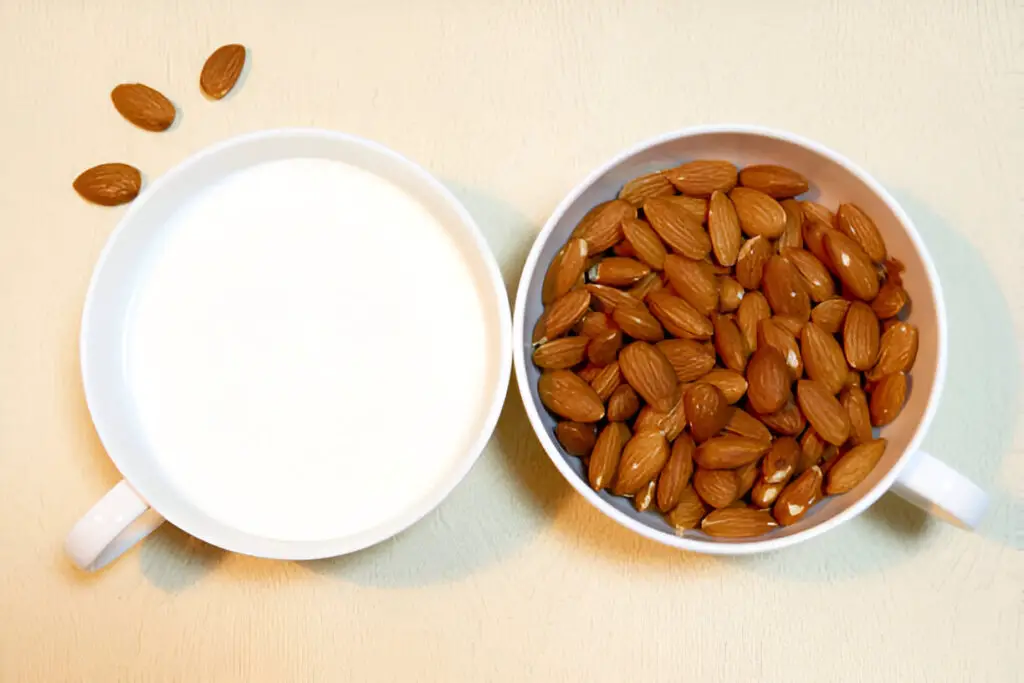Can I Use Almond Milk Powder Instead of Liquid Almond Milk?

So there I was, staring into my pantry at a box of almond milk powder. Yup, almond milk powder. Now, I’ve used liquid almond milk for years—smoothies, baking, coffee, you name it. But powder? That was uncharted territory.
I had the same question you probably do right now: Can I really use almond milk powder instead of liquid almond milk? The answer? Yes—but not without a few twists and turns along the way.
First Off: What Exactly Is Almond Milk Powder?
If you’re like me, you might’ve thought, “Almond milk comes from almonds, so how do you make that into powder?” It sounds like some high-tech food magic, but almond milk powder is simply dehydrated almond milk.
It has the same nutty flavor and creamy texture when reconstituted with water. Think of it like the powdered version of cow’s milk you find in camping packs. But the real question is, does it work in the same ways?
My Experiment: Using Almond Milk Powder Instead of Liquid
When I first decided to give almond milk powder a go, I figured the best way to test it out was in some of my usual recipes. I tried using it in a smoothie, some baking, and—of course—my morning coffee. Spoiler alert: The results were a mixed bag.
Step-by-Step: How I Turn Almond Milk Powder into Liquid Almond Milk

Before diving into how it turned out, let’s talk basics. You can’t just sprinkle almond milk powder into your recipe as is—you need to rehydrate it first. Here’s how I usually make a cup of liquid almond milk from powder:
- Measure the Powder: Typically, you’ll use about 1-2 tablespoons of almond milk powder per cup of water. I like to start with one tablespoon and adjust based on how creamy I want it.
- Add Water: Pour the desired amount of cold or warm water into a glass or bowl.
- Mix Well: Stir it vigorously, or better yet, use a whisk or blender to get rid of any clumps. You want a smooth consistency, just like the almond milk from a carton.
| Liquid Almond Milk | Almond Milk Powder | Water | Result |
| 1 cup | 1-2 tbsp | 1 cup cold/warm water | Smooth, nutty, creamy |
| 1/2 cup | 1 tbsp | 1/2 cup water | Lighter almond flavor |
| 2 cups | 2-4 tbsp | 2 cups water | Creamier, stronger taste |
Once you’ve got your “liquid” almond milk, you can use it just like you would the carton stuff.
Almond Milk Powder in My Morning Coffee
I couldn’t wait to test this out in my morning coffee. Coffee and almond milk are like peanut butter and jelly to me, so this was the ultimate test. After mixing up the almond milk powder, I poured it into my coffee. It didn’t quite blend as smoothly as I’d hoped—it was a bit grainy at first. But after some vigorous stirring, it finally mixed in.
The flavor? Pretty close to the almond milk I’m used to, but the texture was just slightly thinner, and I could still feel the tiniest bit of grit. Not a dealbreaker, but not quite perfect either.
How Almond Milk Powder Performed in Baking
Next up: baking. I whipped up some muffins using almond milk powder in place of liquid almond milk. Here’s the thing—once you mix the powder into your batter, it behaves almost exactly like liquid almond milk.
My muffins came out light and fluffy, and I couldn’t taste any difference. If you’re using almond milk powder for baking, it’s basically foolproof, which was a huge relief!
| Recipe | Almond Milk Powder Performance | Result |
| Coffee | Grainy texture, but similar taste | Slightly thinner and gritty |
| Muffins | Smooth blending into batter | Light, fluffy, and no flavor change |
| Smoothies | Blended well with other ingredients | Slightly thinner, but still creamy |
Almond Milk Powder in Smoothies
I use liquid almond milk in smoothies all the time, so I had to see if the powder could hold its own in my go-to green smoothie. After blending it with spinach, bananas, and some frozen berries, the powder version worked just fine.
Honestly, it blended so smoothly with everything else that I couldn’t tell the difference. The texture was a little thinner, but it didn’t water down the flavor, which was a pleasant surprise.
What Makes Almond Milk Powder Stand Out?
If you’re someone who’s always on the go or trying to keep your kitchen clutter-free, almond milk powder has its perks. Here’s why I found it useful:
- Shelf-Stable: Unlike liquid almond milk, which needs refrigeration and spoils in a week or so, almond milk powder lasts forever (well, almost). You can keep it in your pantry for months, and it’s perfect for those “oops, I’m out of milk” moments.
- Space-Saving: I’ll admit it—my fridge is always packed, and almond milk cartons take up a ton of space. With the powder, I don’t have to worry about that. It’s a compact option that’s easy to store.
- Customizable: One of my favorite things about almond milk powder is that you can adjust the creaminess. Add more powder for a richer, creamier almond milk, or use less for a lighter version. It’s all in your control.
| Pros of Almond Milk Powder | Cons of Almond Milk Powder |
| Shelf-stable for months | Can be grainy or gritty if not mixed thoroughly |
| Saves fridge space | Slightly thinner than liquid almond milk |
| Customizable creaminess | Not as rich in flavor in certain applications |
| Travel-friendly | Might not work well in recipes needing thick liquids |
The Downsides of Almond Milk Powder
Of course, almond milk powder has its downsides too. It’s not all smooth sailing. I noticed that it doesn’t always dissolve completely, leaving behind tiny bits of powder in my coffee or oatmeal. If you’re a texture-sensitive person (like I am with certain foods), that slight grittiness can be a little off-putting.
Also, while it works great in most recipes, the thinner texture doesn’t always lend itself to dishes where you need a creamier base, like in soups or creamy sauces.
| Also read: How to Make Almond Milk Yogurt with Store-Bought Almond Milk? |
Almond Milk Powder vs. Liquid Almond Milk: A Quick Comparison
To give you a clearer picture, here’s how almond milk powder stacks up against its liquid counterpart:
| Aspect | Almond Milk Powder | Liquid Almond Milk |
| Shelf Life | Long (months) | Short (7-10 days after opening) |
| Texture | Can be grainy, slightly thinner | Smooth and creamy |
| Convenience | Compact and travel-friendly | Requires refrigeration |
| Flavor | Slightly neutral, customizable | Consistent, richer flavor |
| Best Uses | Baking, smoothies, coffee | Everyday use, cooking, and sauces |
My Final Verdict: When to Use Almond Milk Powder
After all the mixing, baking, and sipping, I came to the conclusion that almond milk powder definitely has a place in my kitchen. Here’s when I’d recommend it:
- Baking: If you’re making muffins, cakes, or bread, almond milk powder works perfectly. It dissolves well and gives you the moisture and mild flavor you’d expect from liquid almond milk.
- Travel or Storage: For camping trips or emergencies, almond milk powder is a lifesaver. It’s lightweight, portable, and has a long shelf life—perfect when you can’t lug a carton of almond milk around.
- Smoothies: While the texture is a little thinner, almond milk powder blends well into smoothies, adding that nutty flavor without being too overpowering.
But for recipes that need a creamy consistency—like sauces, soups, or rich coffee—liquid almond milk still reigns supreme. The powder might be convenient, but it’s not a perfect one-to-one replacement in every scenario.
The Bottom Line
So, can you use almond milk powder instead of liquid almond milk? Absolutely. But it depends on what you’re making and your personal preferences. Almond milk powder shines in situations where convenience is key, but for ultra-creamy or thick recipes, you might want to stick with the liquid version.
Either way, almond milk powder definitely surprised me with its versatility, and I’m keeping a stash of it in my pantry from now on. Give it a shot and see how it works for you—you might just find a new kitchen staple!






